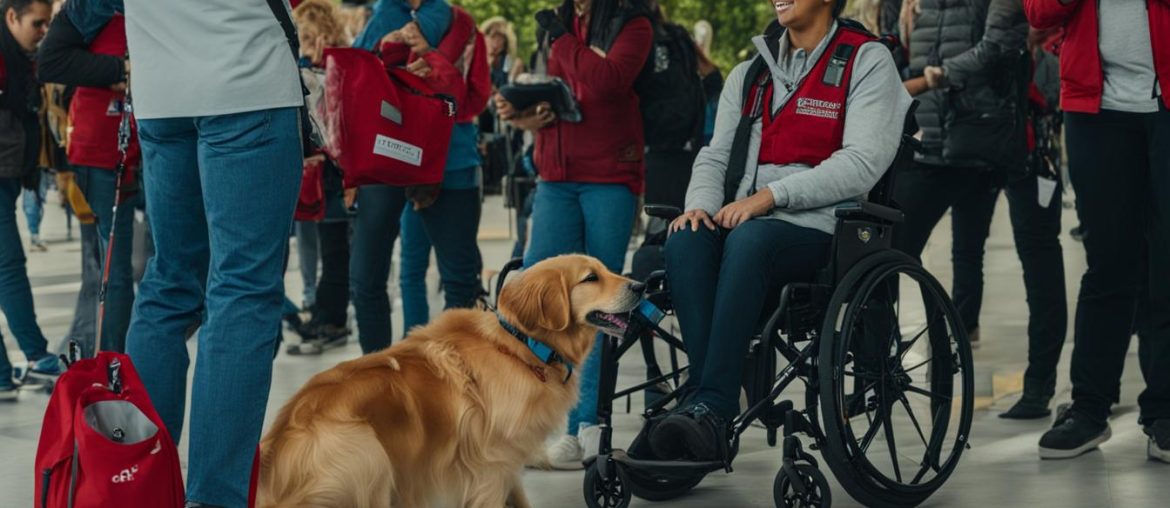Making your dog a service dog involves specific training and qualifications. It is important to understand the requirements and steps involved in the process to ensure your dog can effectively assist you as a service dog.
Key Takeaways:
- Service dogs require specific training and qualifications to effectively assist individuals with disabilities.
- Qualifying for a service dog involves having a physical, emotional, or mental health disability that limits major life activities.
- Training a service dog involves teaching the dog specific tasks related to the handler’s disability.
- Service dogs must pass a public access test to accompany their handlers in public places.
- Service dog certification and registration are optional, but can help identify the dog as a trained service dog.
Qualifying for a Service Dog
To qualify for a service dog, you must have a physical, emotional, or mental health disability that substantially limits one or more major life activities. This means that the disability must significantly impact your ability to perform everyday tasks, such as walking, seeing, or communicating.
The dog itself must be trained to perform tasks that are directly related to your disability. These tasks can include guiding the visually impaired, alerting to sounds for the hearing impaired, providing stability or balance for those with mobility issues, or assisting with tasks for individuals with mental health conditions.
It is important to note that there is no requirement for professional training. While many people choose to work with professional trainers, it is also possible to train your dog yourself. As long as the dog is reliable, well-behaved, and able to perform the necessary tasks, it can qualify as a service dog.
Table: Requirements for Qualifying a Service Dog
| Requirement | Description |
|---|---|
| Disability | Must have a disability that substantially limits one or more major life activities |
| Task Training | The dog must be trained to perform specific tasks directly related to the disability |
| Control | The dog must be under the handler’s control at all times |
| Documentation | No requirement for documentation or proof of disability |
While there is no official certification or registration process for service dogs in the United States, it can be beneficial to obtain optional identification accessories such as vests, patches, or ID cards. These can help clearly identify your dog as a service dog and minimize any potential conflict or confusion in public places.
In summary, qualifying for a service dog involves having a disability that substantially limits major life activities and training the dog to perform tasks directly related to the disability. This training can be done professionally or by the owner themselves. Optional identification accessories can help establish the dog’s status as a service dog.
Training Your Service Dog
Training a service dog is a crucial step in ensuring that it can effectively assist you with your specific disability. The training process involves teaching the dog specific tasks that will aid you in your daily life. The tasks can vary depending on the type of disability you have, but they can include guiding the visually impaired, providing tactile stimulation during panic attacks, reminding you to take medication, or scouting a room for someone with PTSD.
There is no set minimum requirement for the number of training hours a service dog should undergo. However, it is recommended to spend a significant amount of time training in various environments to expose the dog to distractions and unexpected situations. This helps them become more focused and adaptable in real-world scenarios.
To ensure that your service dog is well-trained and prepared for its duties, it is beneficial to seek additional training support resources. These resources provide guidance on different training techniques, tips for reinforcing desired behaviors, and troubleshooting common challenges that may arise during the training process.

| Training Tips | Benefits |
|---|---|
|
|
Training a service dog requires patience, dedication, and consistency. It is important to remember that each dog’s training journey may vary, and it is essential to tailor the training approach to meet the specific needs of your dog and your disability. With proper training and support, your service dog can become a valuable companion and assist you in leading a more independent and fulfilling life.
Passing a Public Access Test
In order for your service dog to be able to accompany you in public places, it must pass a public access test. This test ensures that the dog behaves appropriately in public and does not show aggressive behavior, over-excitement, or excessive barking. The dog should be able to tolerate novel sights and sounds and only relieve itself when given a specific command.
During the public access test, your service dog will be evaluated on various criteria to determine its readiness for public interactions. These criteria may include:
- Walking calmly on a leash without pulling or lunging
- Ignoring distractions such as people, other animals, or food
- Sitting or lying down quietly in public settings
- Responding to commands promptly and reliably
The specific requirements for the public access test may vary depending on your location and the organization you are working with to train and certify your service dog. It is important to consult with a professional trainer or organization to ensure you are aware of the test requirements and can adequately prepare your dog.
| Test Criteria | Pass | Fail |
|---|---|---|
| Leash Skills | The dog walks calmly on a loose leash without pulling or lunging. | The dog pulls on the leash or lunges towards distractions. |
| Distraction Response | The dog remains focused on its handler and ignores distractions such as people, other animals, or food. | The dog becomes overly excited or reactive towards distractions. |
| Settling Behavior | The dog sits or lies down quietly in public settings. | The dog displays restlessness or is unable to settle in public. |
| Command Responsiveness | The dog responds promptly and reliably to commands given by its handler. | The dog fails to respond to commands or displays disobedience. |
Passing the public access test is crucial for your service dog to be granted access to public places. It ensures that your dog is well-behaved and capable of handling the demands of public environments. By successfully passing the test, you can have confidence in your service dog’s abilities and enjoy the freedom and independence that comes with their assistance.
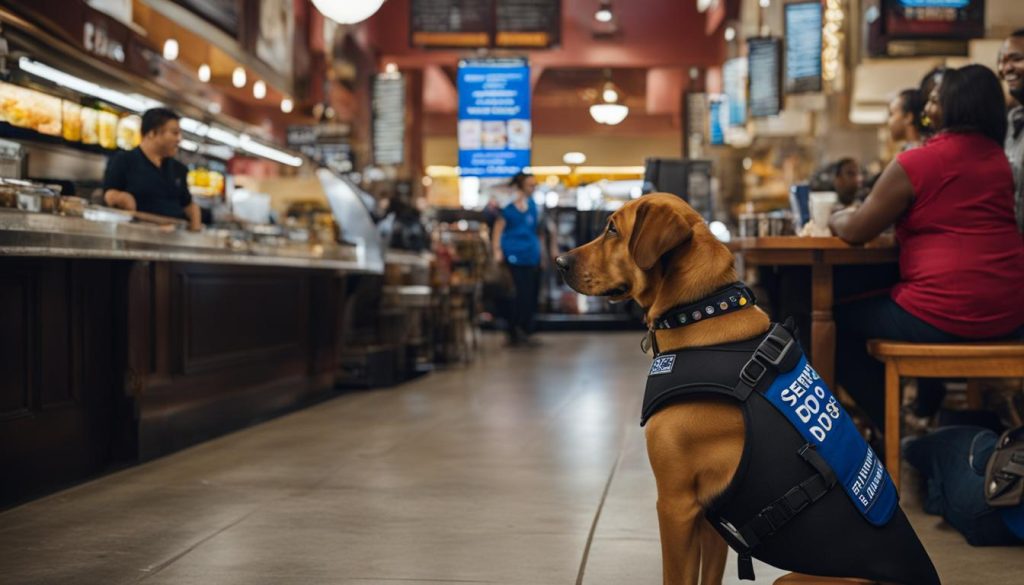
Service Dog Certification and Registration
When it comes to certifying and registering your service dog, there is no legal requirement for these documents in the United States. However, many owners choose to obtain certification and registration to provide clarity and ease of identification for their service dog. While the American with Disabilities Act (ADA) does not require staff at public establishments to request any documentation, having identification can help prevent misunderstandings or confusion.
Service dog certification and registration can come in various forms, including identification cards, vests, or patches. These accessories can clearly indicate that your dog is trained and at work. They can also serve as a visual signal to others that your dog is a service dog and should be given the appropriate access and accommodations.
It’s worth noting that there are organizations that offer service dog certification and registration programs. These programs typically involve an evaluation of your dog’s training and behavior. However, it’s important to choose a reputable organization that follows established standards and guidelines for certification. Doing so will ensure that your certification holds merit and is recognized by others.
| Benefits of Service Dog Certification and Registration |
|---|
| Clear identification for your service dog |
| Easier interactions with staff at public establishments |
| Prevention of misunderstandings or confusion regarding your dog’s role |
| Access to additional support or resources for service dog owners |
While obtaining certification and registration is a personal choice, it can provide peace of mind and facilitate smoother interactions while navigating public spaces. It’s important to remember that the primary focus is on training and ensuring your service dog is well-behaved, responsive, and able to perform the necessary tasks related to your disability.
Differentiating Emotional Support Dogs and Service Dogs
When it comes to assistance animals, there is often confusion between emotional support dogs and service dogs. While both can provide valuable support to individuals, there are distinct differences in their training, legal rights, and access. Understanding these differences is essential for those seeking the appropriate assistance and for organizations accommodating individuals with disabilities.
Emotional support dogs are specifically trained to provide comfort, companionship, and emotional support to individuals with mental health or emotional conditions. Unlike service dogs, emotional support dogs do not require any specific training or certification. They are typically recommended by mental health professionals and can assist in alleviating symptoms such as anxiety, depression, or stress. While emotional support dogs offer emotional support, they are not granted the same legal rights or public access as service dogs.
Service dogs, on the other hand, are extensively trained to perform specific tasks that mitigate the effects of a person’s disability. These disabilities can be physical, sensory, psychiatric, intellectual, or other mental health conditions. Service dogs undergo rigorous training to assist individuals in their daily activities and enhance their independence. They are protected by the Americans with Disabilities Act (ADA) and are granted legal rights to accompany their handlers in public places, including restaurants, stores, and public transportation.
“Emotional support dogs provide comfort and emotional support, while service dogs are trained to perform specific tasks for individuals with disabilities.”
It is crucial to note that emotional support dogs and service dogs serve different purposes and have different legal protections. Emotional support dogs are not considered service animals under the ADA, and therefore, they do not have the same public access rights. While emotional support dogs can provide significant benefits to individuals, they may be subject to specific housing accommodations under the Fair Housing Act.
| Emotional Support Dogs | Service Dogs | |
|---|---|---|
| Training | No specific training required | Extensive training to perform tasks related to disabilities |
| Legal Rights | Limited to housing accommodations | Full public access rights under the ADA |
| Access to Public Places | Not allowed in most public places | Allowed in public places with their handlers |
To summarize, emotional support dogs and service dogs play distinct roles in assisting individuals with disabilities. Emotional support dogs provide comfort and emotional support, while service dogs are trained to perform specific tasks for individuals with disabilities. It is important to respect the legal rights and access of service dogs, while also recognizing the value that emotional support dogs bring to individuals with mental health conditions.
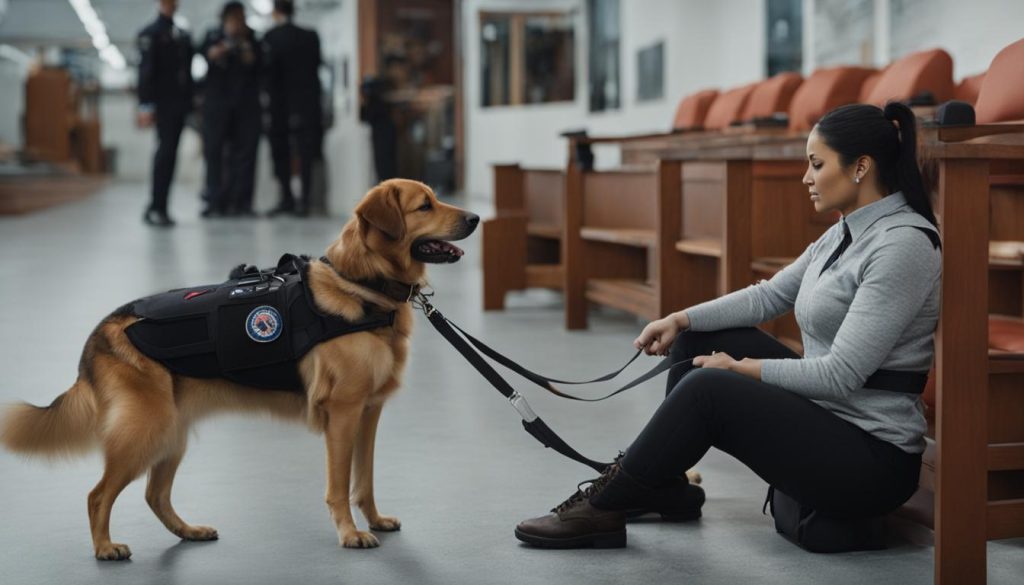
Understanding Service Dog Rights and Access
As a service dog owner, it is crucial to have a thorough understanding of the rights and access that come with having a service dog. Service dogs are afforded specific protections under the Americans with Disabilities Act (ADA), allowing them to accompany their handlers in public places. Let’s explore the key aspects of service dog laws and access rights.
Service Dog Laws Under the ADA
The ADA defines a service animal as a dog trained to perform tasks for individuals with disabilities. These tasks can range from guiding the visually impaired to alerting someone to an approaching seizure. Please be aware that service dogs are not required to wear any special vest or identification. However, staff at public establishments are allowed to ask only two questions to determine if a dog is a service animal:
- Is the dog a service animal required because of a disability?
- What tasks has the dog been trained to perform?
It is crucial for service dog owners to know and assert their rights when faced with potential discrimination or access issues. If a service dog behaves aggressively, is not under the control of the handler, or poses a direct threat to the health or safety of others, they may be excluded from certain places.
Public Access Rights for Service Dogs
Service dogs have the right to accompany their handlers in numerous public places, including but not limited to:
- Restaurants and cafes
- Hotels and lodging facilities
- Retail stores and shopping centers
- Schools and universities
- Public transportation
It’s important to keep in mind that each individual state may have additional regulations or protections in place for service dogs.
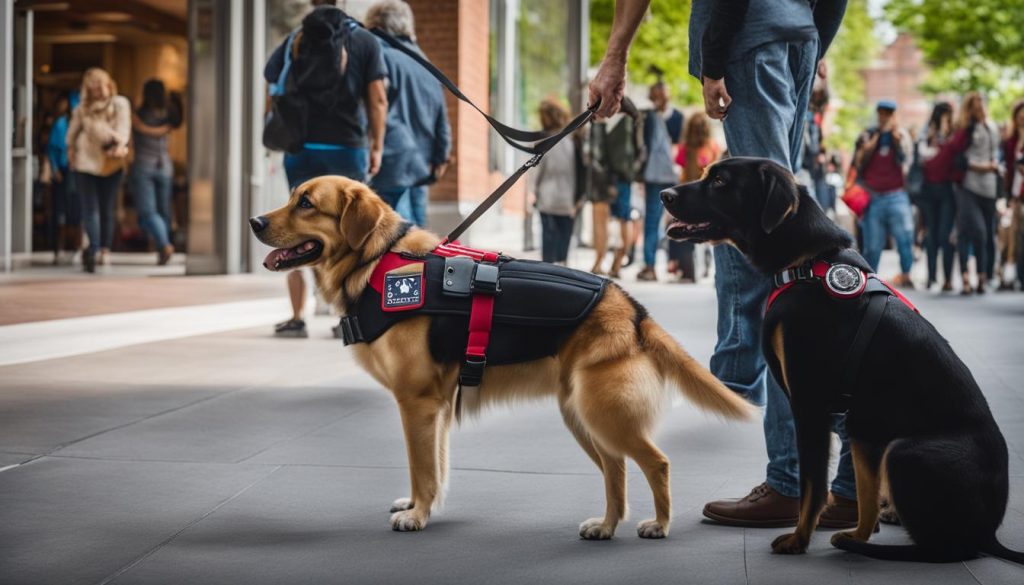
| Public Places | Access Rights |
|---|---|
| Restaurants and cafes | Service dogs allowed, regardless of any “no pets” policies. |
| Hotels and lodging facilities | Service dogs allowed, including in non-pet-friendly rooms. |
| Retail stores and shopping centers | Service dogs allowed, even in stores where pets are not typically permitted. |
| Schools and universities | Service dogs allowed in classrooms, libraries, and other facilities. |
| Public transportation | Service dogs allowed on buses, trains, and planes, free of charge. |
Service dog owners should be prepared to advocate for their rights if faced with any challenges or resistance from individuals who may be unaware of the laws and regulations surrounding service dogs.
“Service dogs play a vital role in the lives of individuals with disabilities, providing assistance and support that promotes independence. It is important for society as a whole to understand and respect the rights of service dog handlers, ensuring equal access and opportunities for all.”
Benefits and Types of Service Dogs
Service dogs play a crucial role in assisting individuals with disabilities by performing specific tasks tailored to their needs. These highly trained canines offer a wide range of benefits, enhancing the quality of life for their handlers. Let’s explore the different types of service dogs and the advantages they bring.
Types of Service Dogs
Service dogs come in various breeds and are trained to fulfill different functions based on the handler’s disability. Here are some common types:
- Guide Dogs: These dogs assist individuals with visual impairments, guiding them safely and helping them navigate obstacles.
- Hearing Dogs: Specifically trained for the deaf or hard of hearing, these dogs alert their handlers to sounds such as alarms, doorbells, or approaching people.
- Medical Alert Dogs: These dogs are trained to detect changes in their handler’s body odor or behavior, providing alerts for conditions like diabetes, seizures, or allergies.
- Mobility Assistance Dogs: These dogs help individuals with physical disabilities by fetching items, opening doors, and providing stability and balance support.
- Psychiatric Service Dogs: Trained to assist individuals with mental health conditions, these dogs provide emotional support, perform grounding techniques, and interrupt self-destructive behaviors.
Benefits of Service Dogs
Service dogs offer numerous advantages to individuals with disabilities:
- Increased Independence: With the help of a service dog, individuals can gain more independence and perform daily activities with ease.
- Emotional Support: Service dogs provide companionship and emotional support, reducing feelings of anxiety, stress, and loneliness.
- Enhanced Safety: These dogs are trained to respond to specific situations, ensuring the well-being and safety of their handlers.
- Improved Social Interactions: Service dogs serve as a bridge, facilitating social interactions and reducing social barriers for individuals with disabilities.
- Increased Confidence: Having a service dog by their side boosts the confidence of individuals, empowering them to face challenges head-on.
Service dogs are incredible companions that provide vital assistance to individuals with disabilities, enabling them to lead more independent and fulfilling lives.
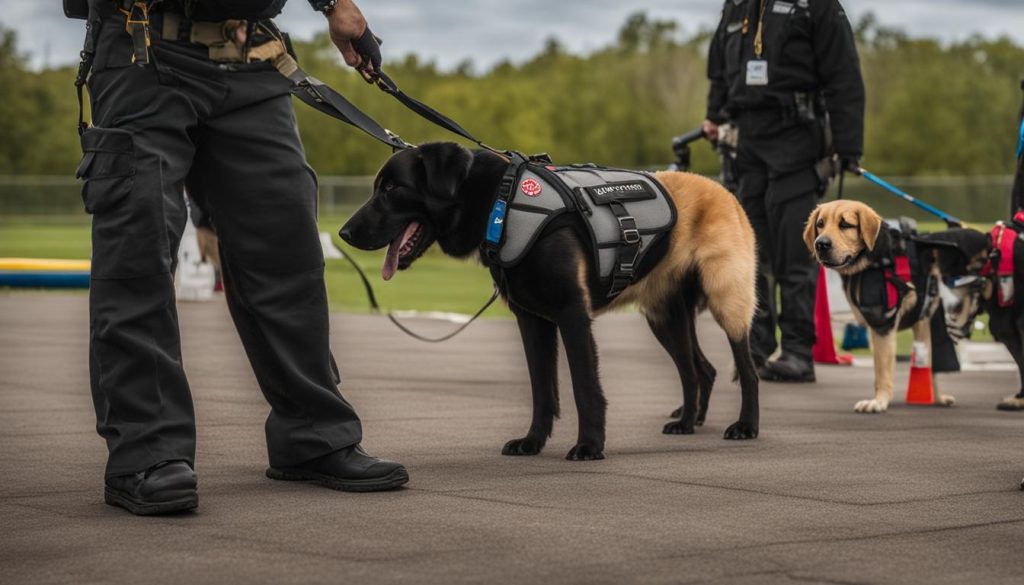
Wrapping Up
To summarize, the process of making your dog a service dog requires dedication, training, and understanding of service dog rights and access. By following the proper steps and ensuring that your dog is capable of performing specific tasks related to your disability, you can create a strong bond and partnership with your service dog.
Service dogs play a crucial role in providing invaluable assistance and support to individuals with disabilities. They enable greater independence and help improve the quality of life for their handlers. Whether it’s guiding the visually impaired, alerting to medical issues, or aiding with mobility, service dogs are capable of performing a wide range of tasks.
Remember, becoming a service dog owner is a serious commitment. It is important to ensure that your dog is well-trained, under your control at all times, and behaves appropriately in public places. Understanding and asserting your rights as a service dog owner is essential to ensure a smooth and respectful interaction with the public and staff at various establishments.
If you are considering making your dog a service dog, consult with professionals in the field who can provide guidance and support throughout the training and certification process. With the right preparation and dedication, you can transform your loyal companion into an invaluable service dog, enhancing your daily life and fostering a strong and mutually beneficial partnership.
FAQ
What are the requirements to qualify for a service dog?
To qualify for a service dog, you must have a physical, emotional, or mental health disability that substantially limits one or more major life activities.
Does a service dog need professional training?
The dog must be trained to perform specific tasks related to your disability, but the training does not necessarily have to be done professionally.
How should I train my service dog?
Training a service dog involves teaching the dog specific tasks that will assist you with your disability. There is no set minimum requirement for training hours, but it is recommended to spend a significant amount of time in public to expose the dog to distractions and unexpected situations.
What tasks can a service dog perform?
Service dogs can be trained to perform tasks such as guiding the visually impaired, providing tactile stimulation during panic attacks, reminding you to take medication, or scouting a room for someone with PTSD.
What is a public access test?
A public access test ensures that the service dog behaves appropriately in public and does not show aggressive behavior, over-excitement, or excessive barking.
Do I need service dog certification and registration?
Service dog certification and registration are not legally required in the United States, but some owners choose to obtain these documents and accessories to signal that their dog is trained and at work.
What is the difference between emotional support dogs and service dogs?
Emotional support dogs provide comfort and emotional support to individuals, but they do not have the same legal rights and access as service dogs. Service dogs are specially trained to perform tasks for individuals with disabilities.
What are the rights of service dogs?
Service dogs have full public access rights under the ADA and are allowed to accompany their handlers to public places, including schools, workplaces, and transportation.
What are the benefits and types of service dogs?
Service dogs provide numerous benefits to individuals with disabilities and can assist with a wide range of tasks specific to the handler’s disability. Common breeds include Labrador Retrievers, Golden Retrievers, and German Shepherd Dogs.


